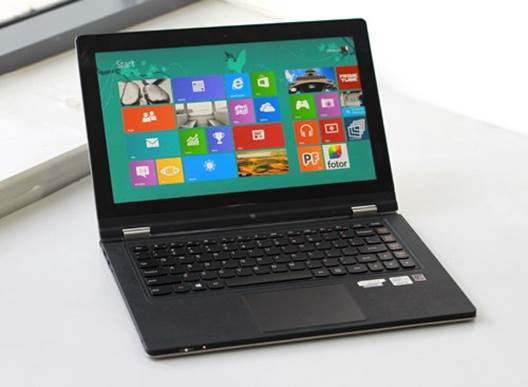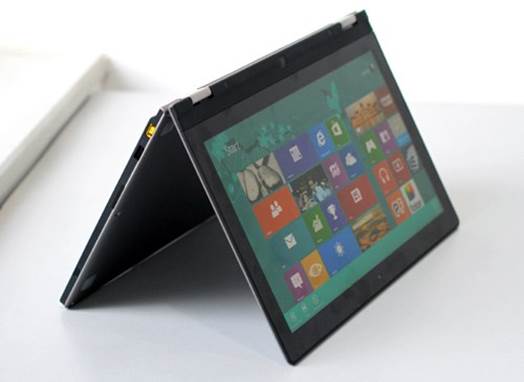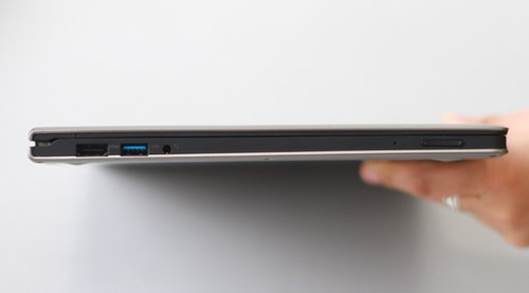Lenovo Yoga 13 delivers high performance and
good runtime thanks to Intel’s latest ULV processor introduced last year as
well as the unique convertible design.
Lenovo Yoga 13 is among the most typical laptops
for the trend of “transforming” introduced last year. However, instead of either
a design which can slide or a detachable keyboard, the product goes on its own
way with a hinge that can swivel by 360 degree to form a tablet if necessary.

Lenovo
Yoga 13
IdeaPad Yoga 13 uses 13in 1,600x900pixel
display, Intel’s latest Core i3/i5/i7 processor, 4GB/8GB of RAM and 128GB SSD. Our
test model features Core i5-3317U processor (1.7GHz), 4GB of RAM, 128GB SSD and
Intel HD Graphics 4000 GPU.

The
versatile hinge lets you flip its screen back a full 360 degrees.
Yoga 13 retains most from the design of
U-series whose appearance looks like a compact notebook. The device has a
sturdy alloy frame, coated by rubber layer for easy handle. However, this type
of design easily gets dirt as well as doesn’t enhance the product’s elegance.
Though, considering mobility, this is a good option thanks to its weight:
1.54kg, regardless test results showing the good performance and long runtime.

The
rubber coat doesn’t enhance the product’s elegance much.
Specially, the product’s hinge lets you
flip the screen back a full 360 degrees. With the combination of a touchscreen,
when fully flipped, the product can be used as a tablet. However, due to large
size, using the device seems difficult. User only can put the device on tables or
hold it in skew position rather than completely lift it up to use as a
conventional tablet. When flipped back, the machine automatically disables the keyboard
to avoid mistyping. Beside this position, Yoga 13 also supports common folding and
stands by its own when operated (as described by pictures). Folding maneuvers
appears sturdy, without any worry about cables like in Vaio Duo or Toshiba
U920t.
Yoga 13 uses a 13.3in display but the
screen size looks slightly larger than common laptops in the market, because there’s
a thick layer (below the screen) incorporating Windows keyboard, which is the
feature of Windows 8 tablets.
Lenovo’s unique design doesn’t have a wide
range of connectors. The device is equipped with USB 2.0/3.0 ports, HDMI output
and SD reader. There’s no optical drive as well as VGA or LAN port. If these
two connectors are necessary, user has to buy them outbox while some models
sell them inbox.

The
machine has connection limited though there’re lots of spaces on sides.
Aside from the screen which can be flipped,
Yoga 13 doesn’t have much change in arranging interiors, compared to U-series. There’s
a Lenovo-custom Chiclet keyboard. Typing adventure is quite short but feedbacks
are good thus user just needs a little time to get along with. Navigation
buttons come in large size and PgUp/PgDn are nearby for easy browsing webs. It’s
a pity that for such a high price, Yoga 13 doesn’t have any backlight for
low-lit condition.
While there’s not much striking with the
keyboard, Yoga 13 shines with touchpad. The machine’s touchpad is finely
sensitive and moving between small distances on screen is very easy.
Multi-pointing maneuvers perform well. Remarkably, two-finger pressing functions
as right-click, which is such a simple action but it’s not available on many
models. Lenovo takes full advantage of the touch-sensitive surface and two
mouse buttons to maximize working area. These two buttons feel soft and fluent
but barely used as the touchpad’s sensitivity does most of the work.
Display
Yoga 13 uses a 13.3in 1,600x900pixel glass display.
It really shines with sharpness, nice details and colors which are not too blazing
thanks to the HD+ IPS LED panel. However, due to the glass screen, reflection
is unavoidable. When brightness level is nearly max, this issue can be solved,
much better than other common glass screens.

The
display
The display support 10-pointing sensitivity,
thus practice showed that it ran smoothly. Finger detection was good and
accurate even in desktop containing small icons. Besides, though the hinge is
swivelable, when in conventional position the display appeared sturdy being
used with touch features.
Performance
Our test model features Intel Core i5-3317U
(1.7GHz) processor, 4GB of RAM, 128GB HDD and Intel HD Graphics 4000 GPU. Though
this type of low-voltage processor was most blamed for low performance, the
machine showed good results.
With such specs, Yoga 13 got a score of
4.7, graded by Windows Experience Index in Windows 8. Particularly, scores for
processor, RAM, graphics, gaming graphics and HDD were 6.9, 5.9, 6.1, 6.1 and
7.7 respectively.
The type of chipset Yoga 13 uses is Intel
Core i5-3317U (1.7GHz) built on Ivy Bridge platform plus 22nm technology,
delivering lower consumption than the previous 32nm models. This is also the
key to the machine’s low power consumption and high performance.
Coming with the Intel Core i5 ULV processor
is Intel HD Graphics 4000 GPU but graphics performance is really impressive for
such an integrated graphic chip. Tested with the 1,600x900 pixel resolution by
default, we received the score of 3,805, quite impressive for such an
integrated chip. Meanwhile, at the common 1,366x768pixel resolution, the score
peaked at 4,276.
Meanwhile, we played back a HD 720p movie,
turned Wi-Fi off, used headphone instead of stereo at 70% volume (100% volume
in Windows Media Player), set brightness at 50% and let the machine run until
there was 5%. Total time allotted was 5h 48min.
Next, we loaded 10 web pages in Chrome and
enabled 15min auto-load, repeated an online music player, used headphone
instead of stereo at 70% volume, set brightness at 50%, let the machine rum
until there was 5% battery. Total time allotted was 6h 7min.
This is such impressive runtime, up to 6h
in test. It enables user to deal with simple works for 8h without any charger
along.
|
Tech specs
·
Processor: Up to 3rd generation Intel® Core™
i7 processor
·
OS: Windows 8 or Windows 8 Pro
·
Display:13.3" Ultrabook™ with an HD+, IPS
display (1,600x900)
·
Weight: Starting at 3.4 lbs
·
Runtime: Up to 8h
·
Storage: Up to 128GB SSD
·
RAM: Up to 8GB memory
|